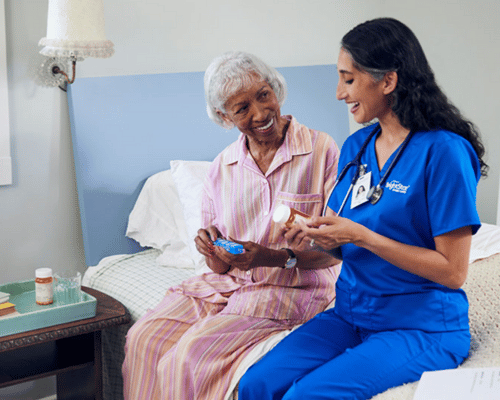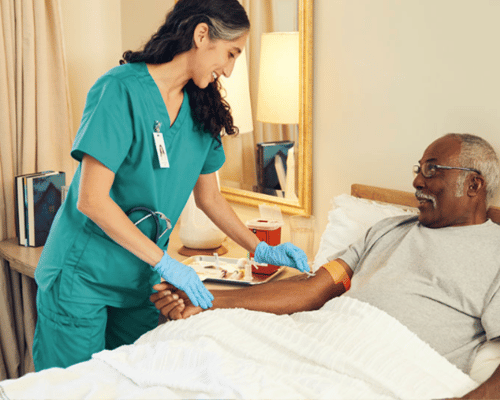Regaining movement after a stroke is a critical milestone in the journey of stroke recovery. A stroke can have a devastating impact on the body, leading to impaired movement, muscle weakness, and loss of coordination. These physical challenges can significantly hinder a person's ability to perform simple daily tasks and diminish independence.
However, there is hope. Physical therapy emerges as a powerful ally in rehabilitation, offering stroke patients a path toward regaining their mobility, strength, and functionality. It is a cornerstone in their recovery journey, enabling them to reclaim control over their bodies and restore their sense of self.
A stroke occurs when the blood supply to the brain is disrupted due to a blockage in a blood vessel (ischemic stroke) or the rupture of a blood vessel (hemorrhagic stroke). Ischemic strokes, caused by clots or plaque buildup, are more common, while hemorrhagic strokes result from blood vessel ruptures. Strokes have severe consequences, leading to damage or death of brain cells.
Recognizing the signs of a stroke, such as weakness, speech difficulties, vision problems, and coordination loss, is crucial for immediate medical intervention. Time is of the essence in stroke treatment to minimize damage and improve recovery prospects. The effects of a stroke on movement are significant, making the restoration of mobility a critical aspect of rehabilitation.
The importance of regaining movement after a stroke cannot be overstated. When a stroke occurs, it often leads to significant impairments in mobility, causing a person to experience weakness, paralysis, and difficulties in coordination. These physical challenges can profoundly impact their daily life and independence.

Regaining movement is a crucial aspect of stroke recovery as it directly affects a person's ability to perform basic activities of daily living. Simple tasks like walking, getting dressed, or feeding oneself can become challenging or impossible without restoring mobility. By regaining movement, stroke survivors can regain control over their bodies and reclaim their independence.
Moreover, regaining movement after a stroke positively impacts well-being and mental health. The loss of mobility can lead to feelings of frustration, helplessness, and a loss of self-confidence. It can also contribute to social isolation and a diminished quality of life. By regaining movement, stroke survivors experience a renewed sense of self-esteem, empowerment, and improved mental well-being.
Physical therapy is critical in stroke rehabilitation by helping patients regain movement, strength, and coordination. Physical therapists use various techniques and exercises tailored to each patient's needs, facilitating muscle re-education, improving balance, and restoring mobility.
Physical therapy offers numerous benefits for stroke patients, including enhanced motor function and coordination. Patients can improve their balance, stability, and overall strength through targeted exercises. Physical therapy empowers stroke survivors to regain independence, enabling them to perform daily activities and engage in a more fulfilling life. Here are some key benefits of physical therapy for stroke patients:

Customizing physical therapy programs for stroke patients is crucial to address each individual's unique needs and limitations. No two stroke survivors are precisely alike, as the effects of a stroke can vary widely depending on the location and severity of the brain damage. Therefore, physical therapists work closely with patients to develop personalized treatment plans that cater to their specific challenges, goals, and abilities.
The customization of physical therapy programs begins with a comprehensive evaluation conducted by the physical therapist. This assessment considers the patient's medical history, the extent of their stroke-related impairments, their current level of function, and their individual goals for recovery. The therapist also considers any additional health conditions or complications impacting the rehabilitation process.
Based on this evaluation, the physical therapist designs a tailored program that addresses the specific needs of the stroke patient. The program typically includes exercises, techniques, and interventions to improve mobility, strength, coordination, and functional abilities. These may involve range-of-motion exercises, balance training, gait training, strengthening exercises, and coordination drills.

Finding the right physical therapy program for stroke recovery is crucial to ensure adequate rehabilitation and optimal recovery. Several factors must be considered when selecting a program that best suits the individual's needs and goals. First and foremost, looking for a program with experienced therapists specializing in stroke rehabilitation is essential. These professionals should have expertise in assessing and treating stroke-related impairments and a comprehensive understanding of the latest evidence-based practices in stroke rehabilitation.
A reputable program will thoroughly evaluate the individual's specific impairments, functional limitations, and rehabilitation goals. This evaluation is the foundation for developing a personalized treatment plan tailored to the individual's needs. In addition to expertise, a multidisciplinary approach is beneficial for stroke recovery. Programs incorporating a multidisciplinary approach involve close collaboration between physical therapists and other specialists, such as occupational therapists, speech therapists, and rehabilitation physicians. This coordination ensures comprehensive care and a holistic approach to recovery.
Location and accessibility are essential considerations in attending regular therapy sessions. The physical therapy facility should be conveniently located and easily accessible for the individual, taking into account transportation options and any potential barriers that may affect consistent attendance. It is also essential to consider insurance coverage and affordability. Checking if the individual's health insurance plan covers the physical therapy program and understanding the coverage details are crucial for long-term affordability.
Overcoming challenges in stroke rehabilitation is a crucial aspect of the recovery journey. Stroke survivors often face various obstacles and setbacks that can hinder their progress and impact their overall rehabilitation outcomes. However, these challenges can be effectively addressed and overcome with the right strategies, support, and mindset.

Setting realistic goals is essential in stroke rehabilitation. It is important to understand that recovery may take time and that progress can vary from person to person. By working closely with the healthcare team, setting realistic goals based on individual abilities and limitations becomes possible. Breaking down larger goals into smaller, manageable steps can provide a sense of accomplishment and maintain motivation throughout recovery.
Integrating physical therapy with other stroke treatments is vital to maximizing the overall effectiveness of stroke recovery. Physical therapy, combined with other essential treatments, such as medication and speech therapy, offers a comprehensive and synergistic approach to rehabilitation. By working collaboratively, healthcare professionals can address multiple aspects of stroke recovery and provide a well-rounded treatment plan tailored to the individual's needs.
Integrating physical therapy with other stroke treatments is facilitated through effective communication and collaboration among healthcare professionals. This interdisciplinary approach allows for shared knowledge, coordinated care plans, and the ability to adapt treatment strategies based on individual progress and needs. Regular communication between physical, speech, and occupational therapists and other healthcare providers ensures a cohesive and comprehensive approach to stroke recovery.
Medication management is often a crucial part of stroke treatment. Medications can help manage underlying medical conditions, prevent blood clots, control blood pressure, and reduce the risk of future strokes. Physical therapy integrates with medication management by complementing the effects of medications. By improving cardiovascular fitness, muscle strength, and coordination, physical therapy can enhance the effectiveness of medications in promoting overall health and reducing stroke risk factors.

Incorporating physical therapy techniques at home is a valuable way to complement and extend the benefits of formal therapy sessions. Open communication with the physical therapist is crucial to integrate these techniques into a home routine. Discuss the exercises and techniques recommended for home practice, seeking clarification on proper form, frequency, and duration. The therapist can provide detailed instructions and tailor the home program to individual needs, considering any precautions or
limitations.
Creating a dedicated space at home for physical therapy exercises is essential. Designate an area that is clear of obstacles, well-lit, and provides enough space to perform the recommended movements comfortably. This designated space serves as a visual reminder and encourages regular engagement in therapy exercises.
Consistency is critical when incorporating physical therapy techniques at home. Establishing a routine that includes dedicated time for therapy exercises is crucial. Treat it as an essential part of the daily schedule, just like any other important activity. It
becomes easier to stay motivated and accountable by making it a regular habit.
Advancements in technology are shaping the future of stroke rehabilitation. Virtual reality, robotics, and other emerging therapies hold promise in enhancing mobility and accelerating recovery. These innovative approaches are expected to revolutionize stroke rehabilitation in the coming years.
Physical therapy is instrumental in helping stroke patients regain movement and rebuild their lives. By providing targeted exercises, personalized care, and ongoing support, physical therapists empower stroke survivors to overcome challenges, regain independence, and significantly improve mobility and overall well-being.

Schedule a free consultation today, or if you are a nurse looking to work in a compassionate environment held to a higher standard, apply today. We invite you to contact us today if you would like to learn more about our services, as well as our other wide range of caregiving services! We are located at 1675 SW Marlow Ave Suite 405, Portland, OR 97225 You can also reach us by phone at (503) 482-8699. Hopefully, we'll hear from you soon!
However, there is hope. Physical therapy emerges as a powerful ally in rehabilitation, offering stroke patients a path toward regaining their mobility, strength, and functionality. It is a cornerstone in their recovery journey, enabling them to reclaim control over their bodies and restore their sense of self.
What is a Stroke?
A stroke occurs when the blood supply to the brain is disrupted due to a blockage in a blood vessel (ischemic stroke) or the rupture of a blood vessel (hemorrhagic stroke). Ischemic strokes, caused by clots or plaque buildup, are more common, while hemorrhagic strokes result from blood vessel ruptures. Strokes have severe consequences, leading to damage or death of brain cells.Recognizing the signs of a stroke, such as weakness, speech difficulties, vision problems, and coordination loss, is crucial for immediate medical intervention. Time is of the essence in stroke treatment to minimize damage and improve recovery prospects. The effects of a stroke on movement are significant, making the restoration of mobility a critical aspect of rehabilitation.
The Importance of Regaining Movement after a Stroke
The importance of regaining movement after a stroke cannot be overstated. When a stroke occurs, it often leads to significant impairments in mobility, causing a person to experience weakness, paralysis, and difficulties in coordination. These physical challenges can profoundly impact their daily life and independence.
Regaining movement is a crucial aspect of stroke recovery as it directly affects a person's ability to perform basic activities of daily living. Simple tasks like walking, getting dressed, or feeding oneself can become challenging or impossible without restoring mobility. By regaining movement, stroke survivors can regain control over their bodies and reclaim their independence.
Moreover, regaining movement after a stroke positively impacts well-being and mental health. The loss of mobility can lead to feelings of frustration, helplessness, and a loss of self-confidence. It can also contribute to social isolation and a diminished quality of life. By regaining movement, stroke survivors experience a renewed sense of self-esteem, empowerment, and improved mental well-being.
How Physical Therapy Aids in Stroke Recovery
Physical therapy is critical in stroke rehabilitation by helping patients regain movement, strength, and coordination. Physical therapists use various techniques and exercises tailored to each patient's needs, facilitating muscle re-education, improving balance, and restoring mobility.
Benefits of Physical Therapy for Stroke Patients
Physical therapy offers numerous benefits for stroke patients, including enhanced motor function and coordination. Patients can improve their balance, stability, and overall strength through targeted exercises. Physical therapy empowers stroke survivors to regain independence, enabling them to perform daily activities and engage in a more fulfilling life. Here are some key benefits of physical therapy for stroke patients:
- Enhanced motor function and coordination: Physical therapy focuses on improving motor skills and coordination, enabling stroke survivors to regain control over their movements. Through targeted exercises and techniques, physical therapists help individuals relearn how to perform specific movements and activities, improving their overall motor function.
- Improved balance and stability: Balance and stability are often compromised after a stroke, leading to an increased risk of falls and injuries. Physical therapy incorporates exercises and interventions that target balance and proprioception, helping stroke patients regain their equilibrium and reduce the risk of falls.
- Increased strength and flexibility: Stroke survivors may experience muscle weakness and tightness, significantly impacting their ability to move and perform daily tasks. Physical therapy utilizes strength training exercises and stretching techniques to improve muscle strength, increase flexibility, and restore the range of motion in affected limbs.
- Enhanced overall mobility and independence: The ultimate goal of physical therapy for stroke patients is to improve their overall mobility and independence. By addressing specific movement impairments, physical therapists help individuals regain the functional abilities necessary for independent living. This includes walking, getting in and out of bed, and performing self-care activities.
- Boosted confidence and quality of life: As stroke survivors regain movement and achieve functional milestones through physical therapy, their confidence grows. This newfound confidence extends beyond physical abilities and positively impacts their emotional well-being and overall quality of life. By regaining independence and participating in activities they enjoy, individuals experience a renewed sense of purpose and fulfillment.
Customizing Physical Therapy Programs for Stroke Patients
Customizing physical therapy programs for stroke patients is crucial to address each individual's unique needs and limitations. No two stroke survivors are precisely alike, as the effects of a stroke can vary widely depending on the location and severity of the brain damage. Therefore, physical therapists work closely with patients to develop personalized treatment plans that cater to their specific challenges, goals, and abilities.The customization of physical therapy programs begins with a comprehensive evaluation conducted by the physical therapist. This assessment considers the patient's medical history, the extent of their stroke-related impairments, their current level of function, and their individual goals for recovery. The therapist also considers any additional health conditions or complications impacting the rehabilitation process.
Based on this evaluation, the physical therapist designs a tailored program that addresses the specific needs of the stroke patient. The program typically includes exercises, techniques, and interventions to improve mobility, strength, coordination, and functional abilities. These may involve range-of-motion exercises, balance training, gait training, strengthening exercises, and coordination drills.

Finding the Right Physical Therapy Program
Finding the right physical therapy program for stroke recovery is crucial to ensure adequate rehabilitation and optimal recovery. Several factors must be considered when selecting a program that best suits the individual's needs and goals. First and foremost, looking for a program with experienced therapists specializing in stroke rehabilitation is essential. These professionals should have expertise in assessing and treating stroke-related impairments and a comprehensive understanding of the latest evidence-based practices in stroke rehabilitation.A reputable program will thoroughly evaluate the individual's specific impairments, functional limitations, and rehabilitation goals. This evaluation is the foundation for developing a personalized treatment plan tailored to the individual's needs. In addition to expertise, a multidisciplinary approach is beneficial for stroke recovery. Programs incorporating a multidisciplinary approach involve close collaboration between physical therapists and other specialists, such as occupational therapists, speech therapists, and rehabilitation physicians. This coordination ensures comprehensive care and a holistic approach to recovery.
Location and accessibility are essential considerations in attending regular therapy sessions. The physical therapy facility should be conveniently located and easily accessible for the individual, taking into account transportation options and any potential barriers that may affect consistent attendance. It is also essential to consider insurance coverage and affordability. Checking if the individual's health insurance plan covers the physical therapy program and understanding the coverage details are crucial for long-term affordability.
Overcoming Challenges in Stroke Rehabilitation
Overcoming challenges in stroke rehabilitation is a crucial aspect of the recovery journey. Stroke survivors often face various obstacles and setbacks that can hinder their progress and impact their overall rehabilitation outcomes. However, these challenges can be effectively addressed and overcome with the right strategies, support, and mindset.
Setting realistic goals is essential in stroke rehabilitation. It is important to understand that recovery may take time and that progress can vary from person to person. By working closely with the healthcare team, setting realistic goals based on individual abilities and limitations becomes possible. Breaking down larger goals into smaller, manageable steps can provide a sense of accomplishment and maintain motivation throughout recovery.
Integrating Physical Therapy with Other Stroke Treatments
Integrating physical therapy with other stroke treatments is vital to maximizing the overall effectiveness of stroke recovery. Physical therapy, combined with other essential treatments, such as medication and speech therapy, offers a comprehensive and synergistic approach to rehabilitation. By working collaboratively, healthcare professionals can address multiple aspects of stroke recovery and provide a well-rounded treatment plan tailored to the individual's needs.Integrating physical therapy with other stroke treatments is facilitated through effective communication and collaboration among healthcare professionals. This interdisciplinary approach allows for shared knowledge, coordinated care plans, and the ability to adapt treatment strategies based on individual progress and needs. Regular communication between physical, speech, and occupational therapists and other healthcare providers ensures a cohesive and comprehensive approach to stroke recovery.
Medication management is often a crucial part of stroke treatment. Medications can help manage underlying medical conditions, prevent blood clots, control blood pressure, and reduce the risk of future strokes. Physical therapy integrates with medication management by complementing the effects of medications. By improving cardiovascular fitness, muscle strength, and coordination, physical therapy can enhance the effectiveness of medications in promoting overall health and reducing stroke risk factors.

Tips for Incorporating Physical Therapy Techniques at Home
Incorporating physical therapy techniques at home is a valuable way to complement and extend the benefits of formal therapy sessions. Open communication with the physical therapist is crucial to integrate these techniques into a home routine. Discuss the exercises and techniques recommended for home practice, seeking clarification on proper form, frequency, and duration. The therapist can provide detailed instructions and tailor the home program to individual needs, considering any precautions or limitations.
Creating a dedicated space at home for physical therapy exercises is essential. Designate an area that is clear of obstacles, well-lit, and provides enough space to perform the recommended movements comfortably. This designated space serves as a visual reminder and encourages regular engagement in therapy exercises.
Consistency is critical when incorporating physical therapy techniques at home. Establishing a routine that includes dedicated time for therapy exercises is crucial. Treat it as an essential part of the daily schedule, just like any other important activity. It
becomes easier to stay motivated and accountable by making it a regular habit.
Future of Physical Therapy in Stroke Rehabilitation
Advancements in technology are shaping the future of stroke rehabilitation. Virtual reality, robotics, and other emerging therapies hold promise in enhancing mobility and accelerating recovery. These innovative approaches are expected to revolutionize stroke rehabilitation in the coming years.Physical therapy is instrumental in helping stroke patients regain movement and rebuild their lives. By providing targeted exercises, personalized care, and ongoing support, physical therapists empower stroke survivors to overcome challenges, regain independence, and significantly improve mobility and overall well-being.

